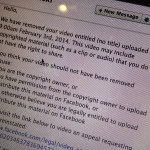My Contribution to the Public Discussion on 512(f) Takedown Abuse

The Southern District of Florida Courthouse where the Court considered EFF’s arguments to make the records public.
Source: Southern District of Florida website and presumed to be a United States Government Work pursuant to 17 U.S.C. § 105.
I am pleased to have played a part in helping the Electronic Frontier Foundation (EFF) set free the sealed records in the Disney v. Hotfile case. I argued in Court this week on EFF’s behalf, and now some documents that had been filed under seal “indefinitely” will be made public in the court file by mid-October, and the parties will be required to come up with a plan to unseal all of the documents currently listed as permanently under seal over the next month and a half. This is an important victory for the dialog surrounding what Register of Copyrights Maria Pallante has dubbed The Next Great Copyright Act.
Disney v. Hotfile and 512(f)
Way back in 2011, Disney, Warner, and other content providers sued cloud file sharing service Hotfile for copyright infringement, arguing that Hotfile could not claim the service provider immunities of 17 U.S.C. § 512 because it did not properly respond to take down notices. Hotfile, in turn, countersued Warner for liability under § 512(f), which provides a remedy when a copyright owner abuses the takedown process. Specifically, Section 512(f) provides:
[blockquote author_name=”” width=”70%” float=”none”](f) Misrepresentations. – Any person who knowingly materially misrepresents under this section —
(1) that material or activity is infringing, or
(2) that material or activity was removed or disabled by mistake or misidentification,
shall be liable for any damages, including costs and attorneys’ fees, incurred by the alleged infringer, by any copyright owner or copyright owner’s authorized licensee, or by a service provider, who is injured by such misrepresentation, as the result of the service provider relying upon such misrepresentation in removing or disabling access to the material or activity claimed to be infringing, or in replacing the removed material or ceasing to disable access to it. Hotfile claimed that Warner had abused the notice and takedown system, in part by taking down material that it knew was not its own. [/blockquote]
The Electronic Frontier Foundation, naturally, has a strong interest in the proper interpretation and application of the notice and take down provisions, and I gladly accepted its request to serve as its pro bono local counsel when it sought amicus curiae, or friend of the court, status. With my help, EFF appeared in the case and provided guidance to the trial court as it analyzed the various issues under Section 512.
The court eventually ruled on the parties’ cross motions for summary judgment. Warner had argued that it could not be liable, as a matter of law, for 512(f) damages, but the trial court said that issues of fact precluded summary judgment. It also made some rulings adverse to Hotfile, and on the eve of trial, Hotfile and the content providers entered into a settlement that resulted in the complete shutdown of the Hotfile in November, 2013.
So wait — if the parties settled in 2013, why am I writing about this now? Because EFF pushed forward to have the basis of the court’s decision made open to the public.
Why were the records sealed?
As so often is the case in modern litigation, the parties during the course of discovery had entered into an agreed protective order allowing them to designate items as “attorney’s eyes only” in order to facilitate the free flow of information. There’s nothing wrong with that, and in fact, Federal Rule of Civil Procedure 26(c) specifically allows for courts to enter such orders. But the parties here took it a step further — Warner asked the Court to let them file many documents, including much of the materials that formed the factual basis of their arguments on the 512(f) summary judgment motion, under seal, so that only the parties and the Court, but not the public, could view the factual basis for the arguments.
The Court allowed dozens of documents to be filed under seal indefinitely. While the parties simultaneously filed public redacted copies, the public was still left with huge swathes of public court files with big black redaction marks. Even the Court’s summary judgment decision [.pdf] contained many lines redacted, so that any reader who was not a party to the case and privvy to the underlying sealed court files would not really have the means to understand the court’s reasoning. Even EFF, though part of the case by its amicus status, did not have access to the sealed materials.
Why I Care and So Should You
This is an issue near and dear to my heart. I’ve written before about my experiences with takedown abuse — from the very earliest days of the DMCA to a dear friend’s most recent run in over her son’s creative endeavors. There is not a lot of case law on §512(f), though the issue pops up in the news from time to time. And the only way parties can tailor their actions to the state of the law is to analogize to the facts in decided cases. That’s the way this whole law thing works. So having a decision without any of the underlying facts removes any value from having a court decision at all.
As one court has explained:
[blockquote author_name=”” width=”70%” float=”none”]Once a matter is brought before a court for resolution, it is no longer solely the parties’ case, but also the public’s case. Absent a showing of extraordinary circumstances…the court file must remain accessible to the public.[/blockquote]
Brown v. Advantage Eng’g, Inc., 960 F.2d 1013, 1016 (11th Cir. 1992).
So together, EFF and I went back to the Court and pushed for the sealed documents surrounding the 512(f) issue to be made public. Seven months later, the court held this week’s hearing on the motion. Ultimately, the court agreed with the principle that records of public decisions must be public, and not only did the court order many of the documents EFF requested be made public in 10 days — the court also ordered that the parties come up with a plan to make every sealed document public. Not just the ones EFF asked for, but all of the sealed records.
A victory for EFF, but more importantly, a victory for the First Amendment, and a victory for the public good. I am honored to have played a part.
Many thanks to Mitch Stoltz and Corynne McSherry for choosing me to work with EFF on this important issue, and to Jim Tyre for making the introductions.


